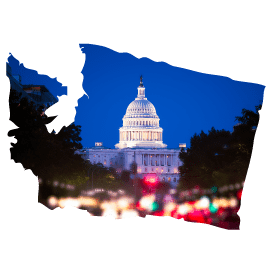Differential Pay: Washington
Retaining Effective Teachers Policy
Analysis of Washington's policies
Washington supports incentives earned by teaching certain subjects. The state offers scholarships or loan repayments and gives priority to candidates seeking certification in math, science, technology or special education. In the past, the Washington Educator Retooling program also provided up to $3,000 a year for two years for existing teachers as an incentive for teaching in subject shortage areas. However, funding for this program is not currently available.
Washington also supports differential pay for those teaching in high-needs schools. Teachers who are National Board Certified are eligible for an additional $5,000 annual bonus if they teach at a low-income school, defined as having at least 70 percent of students qualifying for the free or reduced-price lunch program.
Recommendations for Washington
Expand differential pay initiatives for teachers in subject shortage areas.
Although the state's loan forgiveness program is a desirable recruitment and retention tool for teachers early in their careers, Washington should expand its program to include those already part of the teaching pool, as it previously had with the Educator Retooling program. A salary differential is an attractive incentive for every teacher, not just those with education debt.
State response to our analysis
Washington noted that each year the state budget has provided lower free and reduced-lunch percentage (FRLP) criteria for middle and high schools than provided in statute. In addition, this year the legislature provided only $3,000 for the first year of a teachers National Board bonus on the assumption that teachers are actually certified for only 60 percent of the year in which they receive certification.
The additional bonus for NBCTs is set at 50 percent or greater FRLP in high schools, 60 percent or greater FRLP for middle schools and 70 percent or greater FRLP for elementary schools.
Select another topic
Delivering Well Prepared Teachers
- Admission into Preparation Programs
- Elementary Teacher Preparation
- Elementary Teacher Preparation in Reading Instruction
- Elementary Teacher Preparation in Mathematics
- Middle School Teacher Preparation
- Secondary Teacher Preparation
- Secondary Teacher Preparation in Science
- Secondary Teacher Preparation in Social Studies
- Special Education Teacher Preparation
- Assessing Professional Knowledge
- Student Teaching
- Teacher Preparation Program Accountability
Expanding the Pool of Teachers
Identifying Effective Teachers
- State Data Systems
- Evaluation of Effectiveness
- Frequency of Evaluations
- Tenure
- Licensure Advancement
- Equitable Distribution
Retaining Effective Teachers
Exiting Ineffective Teachers
Research rationale
http://papers.nber.org/papers/w12285.

